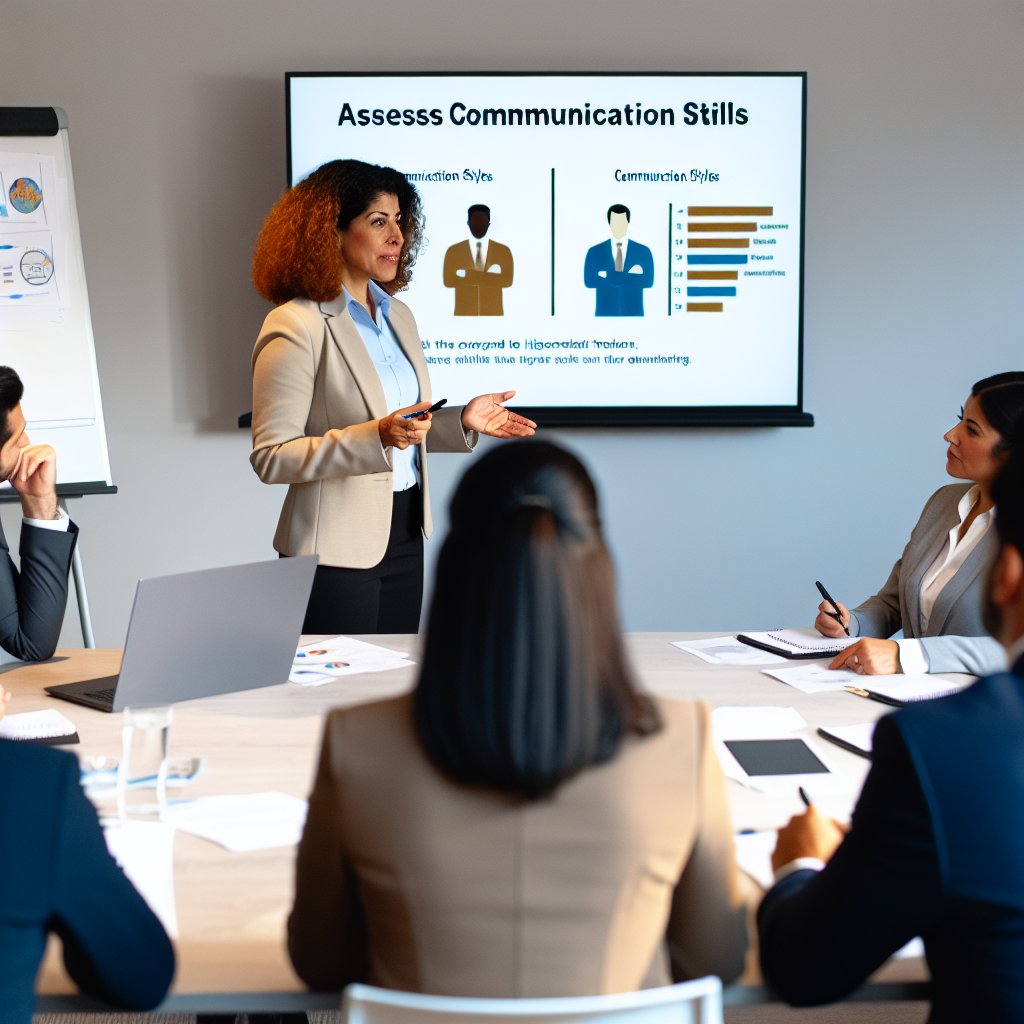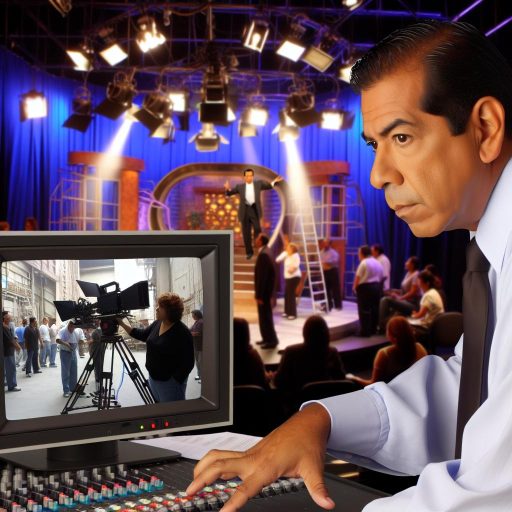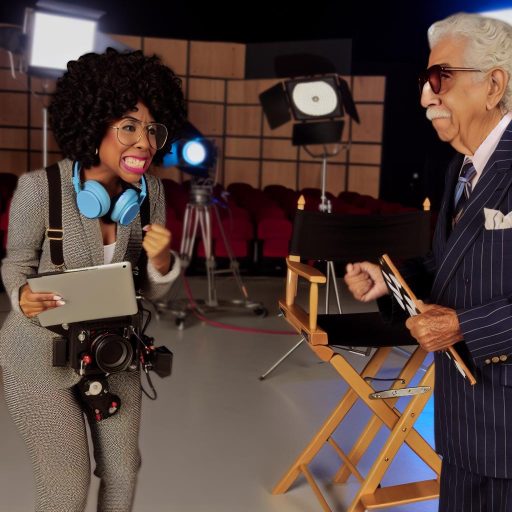Effective communication skills are vital in the corporate world.
They enhance collaboration, drive productivity, and foster innovation.
Clear communication minimizes misunderstandings and builds strong relationships among team members.
In today’s fast-paced environment, good communication can significantly influence an organization’s success.
Corporate trainers play a crucial role in developing these essential skills.
They identify gaps in communication abilities and tailor training programs to address specific needs.
Their expertise helps employees improve verbal and non-verbal communication, active listening, and presentation skills.
Trainers create interactive learning environments that engage participants and facilitate skill enhancement.
The purpose of this blog post is to offer practical advice for assessing communication skills in the workplace.
We aim to provide strategies that corporate trainers can use to evaluate and improve these skills effectively.
This assessment will help organizations build a more competent and confident workforce.
Assessing Communication Skills
Begin by defining the key communication skills you want to assess.
Focus on areas such as clarity, empathy, active listening, and persuasion.
Creating a clear framework will help you evaluate communication prowess effectively.
Utilize various assessment methods to get a comprehensive view.
These methods can include surveys, self-assessments, and peer feedback.
Encourage employees to reflect on their communication style and identify areas for improvement.
Conduct role-playing exercises to simulate real-world scenarios.
This hands-on approach allows participants to practice and receive immediate feedback.
Trainers should observe interactions and offer constructive criticism to enhance learning.
Transform Your Career Today
Unlock a personalized career strategy that drives real results. Get tailored advice and a roadmap designed just for you.
Start NowImplement regular feedback sessions to track progress.
Encourage open discussions about communication challenges and successes.
Continuous feedback promotes a culture of improvement and makes employees feel supported.
Finally, provide resources for ongoing development.
Recommend books, online courses, and workshops to reinforce learning beyond formal training.
Empower employees to take charge of their communication skills, leading to a more effective corporate culture.
Understanding the Basics of Communication Skills
Communication skills encompass the ability to convey information effectively.
They play an essential role in our personal and professional lives.
These skills help us share ideas, build relationships, and work collaboratively with others.
Mastering communication skills can lead to increased productivity and better workplace dynamics.
Defining Communication Skills
Communication skills include various elements necessary for effective interaction.
Here are some key components that define these skills:
- Clarity: The ability to express thoughts clearly and concisely.
- Active Listening: Focusing on understanding the speaker’s message.
- Empathy: Understanding and considering others’ feelings and perspectives.
- Open-Mindedness: Being receptive to different ideas and opinions.
- Feedback: Providing constructive responses to ideas and suggestions.
Different Aspects of Communication Skills
Communication skills can be broadly categorized into three main aspects: verbal, non-verbal, and written communication.
Each aspect is vital in workplace interactions.
Verbal Communication
Verbal communication involves using spoken words to express ideas.
It includes both formal and informal discussions.
Some key characteristics include:
- Pronunciation: Clear articulation of words enhances understanding.
- Tone: The emotion conveyed through voice affects how messages are received.
- Pacing: Speaking too fast or too slow can lead to misunderstandings.
- Confidence: A confident speaker is more likely to engage their audience.
Non-Verbal Communication
Non-verbal communication involves conveying messages without spoken words.
This includes body language, gestures, and facial expressions.
Showcase Your Business Today
Reach thousands of readers actively exploring professional services. Publish your business profile and grow your audience now.
Publish NowImportant elements are:
- Eye Contact: Maintaining eye contact establishes trust and engagement.
- Posture: An open posture can invite communication, while closed posture can discourage it.
- Gestures: Hand movements can emphasize points and convey enthusiasm.
- Facial Expressions: Expressions can communicate emotions and reactions to discussions.
Written Communication
Written communication encompasses all forms of written interaction, from emails to reports.
Vital components include:
- Grammar and Punctuation: Proper grammar helps convey professionalism and clarity.
- Structure: Well-organized writing aids comprehension and keeps the reader engaged.
- Conciseness: Avoiding unnecessary words enhances the message quality.
- Audience Awareness: Tailoring content to the audience’s level of understanding is crucial.
The Importance of Effective Communication Skills in a Professional Setting
Effective communication skills are paramount in any professional environment.
Here are some compelling reasons why they matter:
- Enhances Collaboration: Strong communication fosters teamwork and cooperation among colleagues.
- Improves Productivity: Clear communication prevents misunderstandings, boosting efficiency.
- Builds Trust: Transparent communication helps establish trust within teams and with clients.
- Facilitates Problem-Solving: Open dialogue encourages sharing ideas and finding solutions.
- Supports Professional Growth: Great communicators often enjoy career advancements and opportunities.
Strategies to Develop Communication Skills
Improving communication skills requires consistent practice and self-awareness.
Here are strategies to enhance various aspects of communication:
- Practice Active Listening: Focus on what others are saying without planning your response too quickly.
- Seek Feedback: Request constructive criticism on your communication style to identify areas for improvement.
- Engage in Public Speaking: Join groups like Toastmasters to build confidence in verbal communication.
- Read Regularly: Reading diverse materials can expand your vocabulary and writing skills.
- Record Yourself: Listening to your voice can help identify areas for improvement in verbal communication.
Enhancing Communication for Professional Success
Understanding the basics of communication skills is crucial for professional success.
Clear verbal, non-verbal, and written communication fosters effective interactions among colleagues and clients.
By prioritizing these skills, individuals can enhance collaboration, build relationships, and advance their careers.
Continuous improvement and practice will lead to more effective communication and stronger professional connections.
Common Communication Challenges in the Workplace
Effective communication forms the backbone of any successful organization.
However, many employees encounter challenges that hinder their ability to convey messages clearly.
Understanding these challenges can empower both employees and managers to create strategies that improve communication.
Identifying Common Communication Challenges
Here are some prevalent communication challenges faced by employees in corporate environments:
- Misinterpretation of Messages: Employees may interpret messages differently, leading to confusion.
- Lack of Clarity: Ambiguous language can obscure meaning, preventing the intended message from being understood.
- Information Overload: Employees often receive excessive information, making it difficult to prioritize tasks.
- Cultural Differences: Diverse workplaces may have varied communication styles, which can cause misunderstandings.
- Emotional Barriers: Personal feelings and stress can impact how messages are received and delivered.
- Technological Barriers: Reliance on digital communication can sometimes strip away essential interpersonal elements.
The Impact of Communication Challenges on Productivity and Team Dynamics
Addressing communication challenges is crucial for maintaining high productivity levels.
When communication falters, it can lead to serious repercussions:
- Decreased Productivity: When employees misinterpret instructions, they may waste time on the wrong tasks.
- Increased Conflict: Miscommunication frequently results in disagreements, straining workplace relationships.
- Lower Morale: Constant misunderstandings can lead to frustration, ultimately impacting employee satisfaction.
- Team Cohesion Issues: Teams may struggle to work collaboratively when clarity is lacking, affecting overall performance.
- Delayed Decision-Making: Poor communication can lead to conflicts that stall important decisions, affecting timely project completion.
Real-Life Scenarios of Poor Communication
Understanding real-life scenarios can highlight the importance of effective communication:
- Project Misalignment: A team received vague project guidelines, resulting in multiple members working toward different goals. This led to wasted resources and delayed deadlines.
- Conflict Over Feedback: Two employees misinterpreted feedback from management, which escalated into a heated argument. Their relationship deteriorated, affecting cooperative efforts.
- Client Misinformation: A client misunderstood the scope of a project due to unclear communication. This misalignment led to dissatisfaction and loss of trust.
- Scheduling Conflicts: A team incorrectly assumed a meeting time, causing several key members to miss crucial discussions. This oversight delayed important decisions.
- Failure to Share Updates: A vital update on project progress was not communicated to all stakeholders, leading to confusion about the project’s status. This lack of information stalled further actions.
Enhancing Communication in the Workplace
Communication challenges are common in corporate environments, but they can severely impact productivity and teamwork.
Identifying these challenges is the first step toward resolution.
Employees and managers alike must prioritize clear and open communication to foster a collaborative workplace.
By sharing real-life experiences of communication breakdowns, individuals can understand the essential role effective communication plays in their success.
Employers should invest in training and resources that enhance communication skills, ensuring a positive environment where misunderstandings do not hinder growth.
Addressing communication challenges head-on can lead to improved employee morale, better teamwork, and enhanced productivity.
Emphasizing clarity and creating channels for feedback can greatly mitigate these issues, leading to a more harmonious workplace.
Employers must recognize the importance of communication skills assessment as part of their development programs.
Learn More: The Benefits of Networking for Digital Marketers
Assessing Communication Skills
Assessing communication skills is essential for corporate trainers aiming to enhance employee performance.
Effective communication fuels collaboration and fosters positive workplace environments.
Furthermore, clear communication drives productivity and innovation.
This section explores methods to assess communication skills, offering various techniques and feedback strategies to help trainers implement a comprehensive assessment process.
Evaluation Methods for Communication Skills
Corporate trainers can adopt several evaluation methods to assess communication skills effectively.
Each method has its advantages.
Understanding various approaches allows trainers to select the most suitable option for their specific workplace context.
Role-Playing Exercises
Role-playing exercises immerse participants in real-world scenarios.
Trainers present a situation requiring communication skills, such as a client meeting or a conflict resolution.
Here’s how to implement this method:
- Design relevant scenarios that reflect workplace challenges.
- Divide employees into pairs or small groups.
- Assign roles that participants must act out.
- Encourage participants to perform their roles authentically.
After the role play, trainers guide a debriefing session.
This encourages discussion about what worked well and areas needing improvement.
Role-plays allow trainers to observe skills such as empathy, assertiveness, and clarity in real time.
Showcase Your Business Today
Reach thousands of readers actively exploring professional services. Publish your business profile and grow your audience now.
Publish NowGroup Discussions
Group discussions facilitate assessing interpersonal communication skills.
These discussions encourage collaboration and teamwork.
Here’s how to conduct effective group discussions:
- Identify a relevant topic for discussion.
- Form small groups to promote participation.
- Define clear objectives for the discussion.
- Observe group dynamics and communication styles.
Trainers can assess various skills through this method, including active listening, persuasion, and negotiation.
Group discussions offer insights into how employees interact and communicate within a team.
Feedback Sessions
Feedback sessions are crucial for assessing communication skills.
They involve one-on-one meetings between trainers and employees.
Here’s an effective way to conduct feedback sessions:
- Set a comfortable, private environment for the meeting.
- Begin by discussing strengths observed in the employee’s communication.
- Provide specific examples to illustrate your points.
- Identify areas for improvement, being constructive and clear.
These sessions allow for personalized assessments.
They also create opportunities for employees to reflect on their own skills and set improvement goals.
Additionally, constructive feedback enhances skill development.
Constructive Feedback: Importance and Tips
Delivering constructive feedback is fundamental for skill enhancement.
Constructive feedback focuses on growth rather than criticism.
Here are some reasons why it matters:
- Increases employee morale and motivation.
- Encourages open dialogue and trust.
- Promotes a growth mindset among employees.
To maximize the impact of feedback, trainers should adhere to best practices.
Here are some actionable tips:
Be Specific
Vague feedback can confuse employees.
Instead, trainers should provide specific examples of behaviors.
Focus on Behavior, Not Personality
Feedback should target the behavior rather than the individual.
This approach helps employees not to take criticism personally.
Ensure Timeliness
Offering feedback soon after an observation allows employees to recall situations better.
Timely feedback reinforces learning.
Balance Positive and Negative Feedback
Employ the “sandwich” method.
Start with a positive note, present the area for improvement, and end positively.
This structure helps maintain morale.
Encourage Self-Reflection
Invite employees to assess their performance.
Encourage them to identify their strengths and areas for growth.
This promotes accountability.
Creating Actionable Improvement Plans
After assessment and feedback, establishing improvement plans is essential.
These plans offer clear paths for development.
Here’s how to create effective improvement plans:
- Set SMART goals—Specific, Measurable, Achievable, Relevant, Time-bound.
- Break down larger goals into smaller, manageable tasks.
- Incorporate regular check-ins to monitor progress.
- Provide resources, such as workshops or training materials.
- Encourage peer mentoring or coaching to support skill development.
Actionable plans ensure employees have a clear roadmap.
They can engage in continuous development.
Moreover, this promotes a culture of learning and growth within the organization.
Implications of Communication Skills Assessment
Assessing communication skills requires a structured approach.
Trainers must use various methods like role-playing, group discussions, and feedback sessions.
Each method presents unique advantages and insights into employee capabilities.
Providing constructive feedback is vital to the assessment process.
It fosters growth and encourages improvement.
Implementing actionable improvement plans allows employees to develop continuously.
Showcase Your Business Today
Reach thousands of readers actively exploring professional services. Publish your business profile and grow your audience now.
Publish NowA strong focus on communication leads to enhanced productivity and workplace harmony.
Ultimately, the goal is to cultivate a robust communication culture within the organization.
A commitment to assessing and improving communication skills paves the way for future success.
Delve into the Subject: Developing Clear and Concise Internal Communication Plans
In today’s fast-paced business world, effective communication skills serve as a cornerstone for success.
When corporate trainers design training programs, they must tailor these programs to meet the specific communication needs of employees.
This approach fosters a more targeted learning experience that ultimately leads to improved performance.
Below are key strategies for trainers to customize their communication skill training programs.
Conducting Needs Assessments
Before initiating any training program, trainers should conduct thorough needs assessments.
This process helps identify specific gaps in communication skills among employees.
By understanding the unique challenges faced by different teams, trainers can create relevant content that resonates with participants.
- Interviews and Surveys: Conduct interviews or distribute surveys to gather feedback about current communication challenges. Ensure questions focus on areas like clarity, persuasion, and interpersonal skills.
- Observation: Observe employees in real working scenarios to identify communication gaps. Use these observations to inform your training content.
- Focus Groups: Organize focus groups to discuss communication obstacles. Encourage open dialogue; this will yield rich insights into employee needs.
Identifying Specific Communication Skill Needs
After gathering data from needs assessments, trainers should analyze the findings.
This analysis helps identify core areas requiring improvement.
By focusing on the most pressing issues, trainers can ensure their programs are relevant and effective.
- Team Dynamics: Understand the dynamics of each team. Communication styles may vary significantly across departments, necessitating tailored approaches.
- Role-Specific Skills: Consider the specific roles employees occupy. For instance, sales teams may require negotiation techniques, while support teams need active listening skills.
- Feedback Integration: Encourage employees to provide ongoing feedback about communication challenges. Continuously adapt the training programs to meet evolving needs.
Creating Tailored Training Content
Once needs assessment data is analyzed, trainers should develop customized training content.
The content should align with the specific gaps identified, ensuring relevance and applicability.
Tailored programs lead to better engagement and more effective learning.
- Customized Materials: Develop materials that reflect the industry and specific challenges employees face. Use real-world scenarios to illustrate points effectively.
- Scenarios and Case Studies: Incorporate relevant case studies and scenarios that mimic common workplace situations. This aids in making the training relatable and practical.
- Interactive Workshops: Design interactive workshops that encourage participants to practice and apply their skills. This non-traditional approach fosters a supportive learning environment.
Incorporating Interactive Activities
Interactive activities are essential elements that make training engaging.
They also provide opportunities for hands-on practice.
Trainers should incorporate various activities that encourage participation and collaboration.
- Role-Playing: Use role-playing exercises to simulate challenging communication scenarios. Allow employees to practice different approaches in a safe environment.
- Group Discussions: Facilitate group discussions on specific communication topics. Encourage participants to share their experiences and insights, promoting peer learning.
- Skill Challenges: Develop skill challenges where participants can compete in communication tasks. This healthy competition can enhance motivation and engagement.
Real-Life Simulations
Incorporating real-life simulations can bridge the gap between theory and practical application.
These simulations allow employees to practice skills in realistic contexts.
- Simulated Meetings: Replay meetings where participants can practice effective communication techniques. Focus on aspects like clarity, tone, and assertiveness.
- Feedback Sessions: Provide feedback during simulations, emphasizing both strengths and areas for improvement. Encourage peer feedback for diverse perspectives.
- Recording Sessions: Record practice sessions for later review. Participants can analyze their performance, observe body language, and identify areas for growth.
Evaluating Training Effectiveness
To ensure training programs yield positive outcomes, trainers need to evaluate effectiveness.
Implementing robust evaluation methods leads to continuous improvement.
Feedback helps refine future programs to better serve employee needs.
- Pre- and Post-Training Assessments: Conduct assessments before and after the training to measure skill development. Compare results to quantify improvement.
- Participant Feedback: Collect feedback through surveys and interviews post-training. Understand what worked and what didn’t to enhance future sessions.
- Longitudinal Studies: Evaluate communication skills over time. Monitor employee performance in both collaborative and independent settings to gauge lasting impact.
Tailoring corporate training programs for communication skills enhances both employee development and organizational success.
By thoroughly conducting needs assessments, creating relevant content, and incorporating interactive activities, trainers can deliver impactful training experiences.
Successful communication is a vital asset in the workplace, and trainers play a crucial role in developing this competency.
Emphasizing real-life applications ensures that employees can seamlessly integrate these skills into their daily operations.
Ultimately, trainers should remain adaptive to meet evolving communication demands.
Continuous learning and adjustment of training materials will lead to sustained communication growth within teams.
Through effective assessment and tailored training, corporate trainers can significantly elevate communication competencies across the organization.
Gain More Insights: Learning from the Best: Top VFX Artists to Follow

Strategies for Improving Communication Skills
Effective communication skills play a crucial role in the workplace.
They enhance collaboration, reduce misunderstandings, and foster a positive work environment.
As corporate trainers, it is essential to equip employees with strategies that nurture their communication abilities.
Here are several effective strategies:
1. Emphasize Active Listening
Active listening is a fundamental skill in effective communication.
It goes beyond hearing words; it involves understanding the speaker’s message.
Here are ways to improve active listening:
Showcase Your Business Today
Reach thousands of readers actively exploring professional services. Publish your business profile and grow your audience now.
Publish Now-
Encourage eye contact: Eye contact demonstrates interest.
It encourages the speaker and makes them feel valued.
-
Practice reflective listening: Repeat or paraphrase what the speaker says.
This shows that you understand and are engaged.
-
Eliminate distractions: Encourage participants to focus completely on the speaker.
Turn off phones and eliminate background noise.
-
Ask questions: Encourage trainees to ask clarifying questions.
It helps deepen their understanding of the topic.
-
Provide feedback: Offer constructive feedback on the content of what was shared.
This reinforces active engagement.
2. Promote Clarity in Speech
Clear communication helps prevent misunderstandings.
Trainers should encourage clarity in speech through various methods:
-
Use simple language: Avoid jargon when possible.
Use everyday language to express ideas clearly.
-
Be concise: Encourage brevity in messages.
Short, focused sentences keep the audience engaged without overwhelming them.
-
Structure your messages: Use logical organization.
Start with a main idea, support it with details, then summarize.
-
Practice tone modulation: Encourage trainees to be aware of their tone.
Their tone should match the message being conveyed.
-
Encourage rehearsals: Suggest rehearsing important speeches or presentations.
Practice helps build confidence and improve delivery.
3. Highlight Non-Verbal Communication
Non-verbal cues play a significant role in how messages are perceived.
Trainers should teach employees the importance of body language, facial expressions, and gestures:
-
Teach body language awareness: Discuss how posture and movement influence perceptions.
Confident body language enhances credibility.
-
Utilize facial expressions: Encourage trainees to match their expressions to their messages.
A genuine smile can enhance approachability.
-
Gestures can enhance communication: Appropriate hand gestures can emphasize points.
However, excessive gestures can distract the audience.
-
Promote cultural awareness: Non-verbal communication varies across cultures.
Understanding these differences fosters better workplace interactions.
-
Conduct video feedback sessions: Recording practice sessions allows trainees to see their non-verbal behavior.
This visibility encourages improvement.
4. Foster a Supportive Learning Environment
A supportive environment is essential for effective skill development.
Trainers should create a culture that promotes continuous improvement:
-
Encourage peer feedback: Facilitate peer review sessions.
Allow employees to provide constructive criticism to one another.
-
Create a safe space for practice: Allow employees to practice new skills without fear of judgement.
This encourages experimentation and growth.
-
Provide resources for learning: Offer books, articles, or online courses related to communication skills.
These resources enhance learning beyond the classroom.
-
Celebrate progress: Recognize and celebrate improvements in communication skills.
Positive reinforcement motivates continued effort.
-
Implement follow-up sessions: Schedule periodic reviews of communication skills.
Regular check-ins keep skills sharp and foster ongoing development.
5. Integrate Technology Tools
Incorporating technology can enhance communication skill training.
Trainers can leverage various tools to make learning more effective:
-
Utilize communication apps: Recommend apps that facilitate feedback and discussion, such as Slack or Microsoft Teams.
These platforms encourage collaborative communication.
-
Employ videoconferencing tools: Use platforms like Zoom or Microsoft Teams for remote learning.
These tools help practice communication skills in a virtual setting.
-
Record presentations: Encourage trainees to record and review their presentations.
Self-review fosters self-awareness and improvement.
-
Conduct webinars: Host webinars focusing on specific communication topics.
These interactive formats engage participants in learning.
-
Use online assessment tools: Evaluate communication skills using online assessments.
They can help identify areas for improvement along with progress reports.
6. Encourage Continuous Improvement
Communication skills evolve over time.
Trainers should encourage employees to commit to ongoing enhancement of their abilities:
-
Set personal development goals: Guide employees in setting clear, achievable communication goals.
Goals provide direction and motivation.
-
Promote lifelong learning: Encourage reading and attending workshops on communication skills.
Ongoing learning is vital for long-term success.
-
Incorporate role-play exercises: Use role-playing scenarios to practice real-life situations.
These exercises encourage adaptability and quick thinking.
-
Review success stories: Share examples of excellent communicators within the organization.
Celebrating role models inspires others to improve.
-
Regularly assess skill levels: Conduct assessments periodically to gauge improvements and areas needing focus.
Feedback should be constructive and actionable.
By implementing these strategies, corporate trainers can effectively enhance communication skills within organizations.
Communication is the backbone of collaboration and success in any workplace.
Therefore, prioritizing the improvement of these skills is essential for employees’ professional growth, team dynamics, and overall organizational productivity.
With ongoing support and resources, trainers can foster a culture of effective communication that benefits everyone.
Find Out More: How to Price Your Videography Services Effectively
In the fast-paced corporate world, effective communication skills are essential.
Corporate trainers play a pivotal role in enhancing these skills.
Measuring progress and success in communication skill training programs helps ensure that these initiatives are effective.
In this section, we will explore various ways corporate trainers can assess the impact of their programs.
We will also emphasize the importance of setting clear goals and objectives for employees.
Setting Clear Goals and Objectives
Establishing clear goals and objectives is crucial for effective communication training.
When trainers outline specific outcomes, employees can understand what they need to achieve.
Here’s how to set clear goals:
- Identify Key Competencies: Determine the essential communication skills relevant to the organization. Examples include listening, presenting, and written communication.
- Set SMART Goals: Define goals that are Specific, Measurable, Achievable, Relevant, and Time-bound. For example, “Increase presentation skills to 80% satisfaction rate in three months.”
- Align with Organizational Objectives: Ensure communication goals align with overall business objectives. This alignment reinforces the value of communication training.
- Involve Employees: Engage employees in setting their own goals. This involvement fosters ownership and motivation to improve.
- Communicate Expectations: Clearly convey the training goals to all participants. Ensure they understand what is expected of them.
Setting these goals provides a framework for measurement.
Evaluation against these goals helps trainers assess success over time.
Tracking Improvement Over Time
Trainers can use various methods to measure the progress of communication skills development.
Each method offers unique insights.
Here are some reliable assessment techniques:
- Surveys: Administer pre-training and post-training surveys. Ask participants to rate their confidence and competence in specific communication skills. Compare the results to identify improvements.
- Self-Assessments: Encourage employees to reflect on their skills through self-assessment tools. Include questions about their communication strengths and areas for improvement.
- Performance Evaluations: Incorporate communication skills assessments into regular performance reviews. Supervisors can provide feedback based on observable behaviors.
- Peer Feedback: Implement peer review systems. Colleagues can assess each other’s communication skills to provide a well-rounded perspective.
- Observation: Trainers can observe employees during meetings, presentations, and interactions. Real-time feedback helps identify strengths and weaknesses.
Combining these assessment methods gives a comprehensive view of skill development.
It allows corporate trainers to tailor future training to meet participant needs.
Analyzing Results and Adjusting Training
Once trainers have collected data on employee performance, analysis is crucial.
Here are steps to effectively analyze results and make adjustments:
- Review Data Regularly: Assess the collected data periodically. Regular reviews help spot trends and changes in communication skills.
- Identify Patterns: Look for patterns in the data. For instance, observe which skills show the most improvement and which need more attention.
- Solicit Participant Feedback: Gather feedback from participants about the training experience. Understanding their perspectives can reveal the program’s strengths and weaknesses.
- Modify Training Content: Based on the analysis, update training materials and methods. Tailor content to focus on areas that require more development.
- Set New Goals: As progress is made, set new goals and objectives. Continuously challenging employees keeps them engaged and motivated.
By analyzing results and adapting training methods, corporate trainers can create a cycle of continuous improvement.
This approach ensures that communication skill training evolves with the organization’s needs.
The Importance of Ongoing Training
Measuring progress in communication skills is not a one-time task.
Ongoing training plays a significant role in long-term development.
Here’s why ongoing training is invaluable:
- Adaptation to Change: The corporate environment changes rapidly. Ongoing training helps employees adapt to new communication tools, platforms, and practices.
- Skill Reinforcement: Continuous training reinforces skills learned previously. Regular practice aids retention and mastery of communication skills.
- Employee Growth: Ongoing training supports employee career development. Enhancing communication skills can open doors to promotions and new opportunities.
- Team Dynamics: Regular training fosters collaboration among team members. Improved communication leads to better teamwork and project outcomes.
- Organizational Culture: A commitment to ongoing training promotes a culture of learning. It attracts and retains talent who value personal and professional growth.
Measuring progress and success in communication skill training is vital.
Trainers need to set clear goals and objectives.
Various methods such as surveys, self-assessments, and evaluations help track improvement.
Showcase Your Business Today
Reach thousands of readers actively exploring professional services. Publish your business profile and grow your audience now.
Publish NowAnalyzing results allows for adjustments to training programs.
Ongoing training is essential for maintaining and enhancing communication skills.
By prioritizing measurement and continuous improvement, trainers can significantly impact employee performance and organizational success.
Enhancing Communication Skills in the Workplace
In this blog post, we explored essential advice for assessing communication skills in a corporate setting.
We discussed various methods to evaluate these skills effectively.
Regularly assessing communication abilities leads to enhanced team dynamics and productivity.
We highlighted the importance of active listening during communication assessments.
Active listening fosters understanding and empathy among team members.
It reduces misunderstandings, which often derail projects or hinder collaboration.
We also examined the role of clear and concise messaging.
Clear communication ensures that messages are understood and minimizes confusion.
Furthermore, we emphasized real-world scenarios for assessment.
Role-playing or simulations provide practical experience and allow employees to practice in a safe environment.
Observing employees during these scenarios gives valuable insights into their communication strengths and weaknesses.
Each point reinforces the importance of effective communication in the workplace.
Strong communication skills correlate directly with team performance and employee satisfaction.
Organizations that prioritize communication training witness a marked increase in collaboration and innovation.
Employees feel empowered to express ideas and share feedback, creating a more engaged workforce.
We encourage corporate trainers to invest time and resources in communication skill training.
This investment pays off by fostering a productive and cohesive work environment.
When employees communicate effectively, they improve relationships with clients and colleagues alike.
Consistent assessment and training in communication skills is vital.
It not only enhances workplace productivity but also nurtures a culture of openness.
By prioritizing these strategies, you cultivate an environment where collaboration thrives.
Additional Resources
ADA Requirements: Effective Communication | ADA.gov
Health advisory on social media use in adolescence
[E-Books for Sale]
The Big Book of 500 High-Paying Jobs in America: Unlock Your Earning Potential
$19.99 • 500 High-Paying Jobs • 330 pages
Explore 500 high-paying jobs in America and learn how to boost your career, earn more, and achieve success!
See All 500 High-Paying Jobs of this E-Book
1001 Professions Without a Degree: High-Paying American Jobs You Can Start Now
$19.99 • 1001 Professions Without a Degree • 174 pages
Discover 1001 high-paying jobs without a degree! Unlock career tips, skills, and success strategies for just $19.99!




